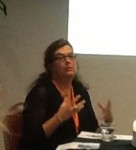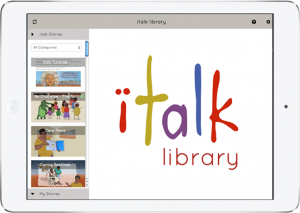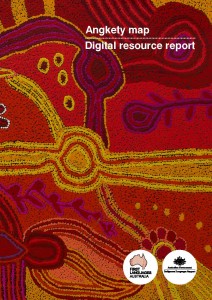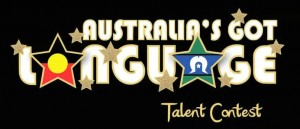At the Puliima National Indigenous Language & Technology Forum, a panel was convened to discuss “Protecting rights and promoting access to Indigenous language materials.” The panelists were Cathy Bow from the Living Archive of Aboriginal Languages at Charles Darwin University, Karen Manton from the Centre of Australian Languages and Linguistics at Batchelor Institute of Indigenous Tertiary Education, Des Crump, the Indigenous Languages Coordinator at the State Library of Queensland, and Sandra Morrison from the Warumungu community around Tennant Creek area.
 Cathy opened the discussion with some background about how digital technology has led to a huge increase in the creation and publication of Indigenous language materials, and while this gives rise to many opportunities, it also creates new challenges. Indigenous and non-Indigenous perspectives on intellectual property differ in some aspects, for example the focus in Western copyright law on the protection of individual rights, while Indigenous tradition favours community and corporate ownership of knowledge and stories. In addition, there is a lack of legal recognition to the rights of Indigenous people to owning the intellectual property contained in some materials for which copyright may belong elsewhere.
Cathy opened the discussion with some background about how digital technology has led to a huge increase in the creation and publication of Indigenous language materials, and while this gives rise to many opportunities, it also creates new challenges. Indigenous and non-Indigenous perspectives on intellectual property differ in some aspects, for example the focus in Western copyright law on the protection of individual rights, while Indigenous tradition favours community and corporate ownership of knowledge and stories. In addition, there is a lack of legal recognition to the rights of Indigenous people to owning the intellectual property contained in some materials for which copyright may belong elsewhere.
Living Archive of Aboriginal Languages
Cathy spoke of the experience of the Living Archive, where the majority of the material has been sourced from NT government schools which had bilingual education programs, and as such the copyright belongs to the NT government. However, the license given by the government to digitise and publish the materials online does not require any input from the Indigenous owners of the stories (including authors, illustrators, etc). While their moral rights are protected by copyright law, the project team wanted to ensure that people were happy with their material being made available on an open access website, so have been attempting to find all the contributors named in the books (or families of those who have passed away) and asking them to sign a permission form.
With regard to access issues, materials are available on the Living Archive site under a Creative Commons Attribution Non-commercial No Derivs 3.0 License Australia, which allows users to share the material, as long as they attribute the source, don’t use it for any commercial purposes, and don’t share any derivative materials. This last point is somewhat problematic, in balancing the desire to promote access and engagement with the stories in the archive, while also protecting them from misuse. For example, the LAAL Digital Story Competition invites people to engage with the materials in the archive, and stipulates that any derivatives must be approved by the story owners and communities.
A particular challenge in this collection relates to materials that do not name the people involved in the creation of the work. This means it’s not known who can give permission. In some cases, people in the community know who was involved, so the team is trying to collect some of that information. Also, for materials that were not produced in NT government schools, it is necessary to seek a license from the copyright holders, which may be another institution (such as the Catholic Education Office or AuSIL for example). These processes can be time-consuming, but the team thinks they are important in showing respect for both the Western and Indigenous practices of intellectual property.
 CALL Collection – Batchelor Institute
CALL Collection – Batchelor Institute
Karen spoke about Batchelor Institute’s CALL Collection, an archive of Indigenous language materials. Over 40 years, students, staff, linguists, language workers and speakers who want to preserve language and resources for the future have contributed to the Collection. As such it is grounded in good will and relationships. Making items more accessible and growing digital language resources for people is a key focus for the future, and so plans for digitisation and a website are under way.
Among the many issues about consent and access for the Collection, three arise across most activities and reflect the many different people and organisations who have connections with a work — Indigenous Cultural and Intellectual Property (ICIP), moral rights and copyright.
ICIP is the broadest ground, encompassing many works and expressions of culture, including language, and communal, ongoing ownership and rights that aren’t protected by copyright or moral rights. ICIP and consultation with communities, creators, past students and contributors is the starting point for a permission strategy, because these are the people and the ground from which all the works in the Collection have come. Moral rights and copyright are considerations that follow on from and need to be addressed in addition to rather than in opposition with the wider scope of ICIP. For example the Collection’s partnership with LAAL works within exceptions in the Copyright Act, but ICIP and moral rights still have to be addressed, and people’s individual, family or community wishes and consent have to be sought and might redirect a decision or approach.
With these considerations in mind, the CALL Collection is working with Terri Janke and Company to develop cultural protocols and copyright and end user licence agreements, as well as creator, ICIP and community agreements for the digitisation and website project.
Above all the Collection is about those who have created it through their language and materials. During the digitisation and website project the Collection hopes to rekindle those relationships and interests of past and present students and language speakers (like Sandra Morrison on this panel) who have contributed and are keen to contribute to the Collection into the future, and be the guides about permission pathways and access.
State Library of Queensland – Indigenous Languages Collection
Following on from previous points on legal issues, Des focused on the personal aspects of digitising materials in collections. Drawing on State Library collection items, Des raised the notion of moral obligations to communities and families.
One such example was the Archibald Meston Papers collected when Meston was the Chief Protector of Aborigines, Queensland. Meston collected language and cultural knowledge from Aboriginal people across Queensland – due to the imbalance of power, it would be difficult to ascertain whether this information was provided freely or under duress and the threat of being removed. While the Meston material may be out of copyright, the information is about real people; hence there is a moral obligation on the State Library to treat the materials respectfully.
Another example was a State Library project that involved the creation of new knowledge from the Margaret Lawrie collection. The Retold project engaged community members to retell the stories collected by Lawrie and provide further information that accompanied the stories, e.g. songs, dance, string games. Towards the end of the project, a family who ‘owned’ a particular story exercised their custodial rights to not share the story with others at this stage. State Library was obliged to respect their wishes and not publicly share these stories until the family believes it is appropriate.
The issue then for collecting institutions is to find that balance that involves digitising materials for access while respecting the intellectual property and moral rights of communities, families and individuals. This is a sensitive area that requires further consideration which a Panel discussion can only touch on – the work of Terri Janke “Our Culture: Our Future – Report on Australian Indigenous Cultural and Intellectual Property Rights” is an excellent starting point.
Warumungu Community – Tennant Creek area
 Sandra Morrison then spoke from the perspective of an Indigenous community which has recently regained access to a set of tapes recorded in the 1960s. She identified the key issues of seeking permission from the right people to transcribe and analyse these recordings. She highlighted the importance of getting community approval for a project such as this, where there are sensitivities about the knowledge and stories of deceased family members. Beyond a broad approval from community leaders, she pointed out the need to go back to the families of the speakers on the tapes and ask them about whether or not they wanted the tapes to be heard. This requires familiarity with family connections within a community to ensure the proper channels are followed, and also contrasts with the very Western legal system, which prioritises individual rights over corporate or community rights.
Sandra Morrison then spoke from the perspective of an Indigenous community which has recently regained access to a set of tapes recorded in the 1960s. She identified the key issues of seeking permission from the right people to transcribe and analyse these recordings. She highlighted the importance of getting community approval for a project such as this, where there are sensitivities about the knowledge and stories of deceased family members. Beyond a broad approval from community leaders, she pointed out the need to go back to the families of the speakers on the tapes and ask them about whether or not they wanted the tapes to be heard. This requires familiarity with family connections within a community to ensure the proper channels are followed, and also contrasts with the very Western legal system, which prioritises individual rights over corporate or community rights.
Since none of the panellists are lawyers, it was strongly recommended that people seek their own legal advice on these issues. A comment from the audience suggested that the topic requires additional attention and that perhaps some kind of working group could be convened to discuss the issues further. Someone else commented that “a whole conference stream could be devoted to this topic” (see blog entry from Grant Young at Indigenous Digital Excellence).
Anyone who would like to pursue this should contact livingarchive@cdu.edu.au to discuss.
POSTSCRIPT: Ghil’ad Zuckermann has recently released Engaging – A Guide to Interacting Respectfully and Reciprocally with Aboriginal and Torres Strait Islander People, and their Arts Practices and Intellectual Property – which looks to be a useful contribution to this discussion.




 The second ‘
The second ‘